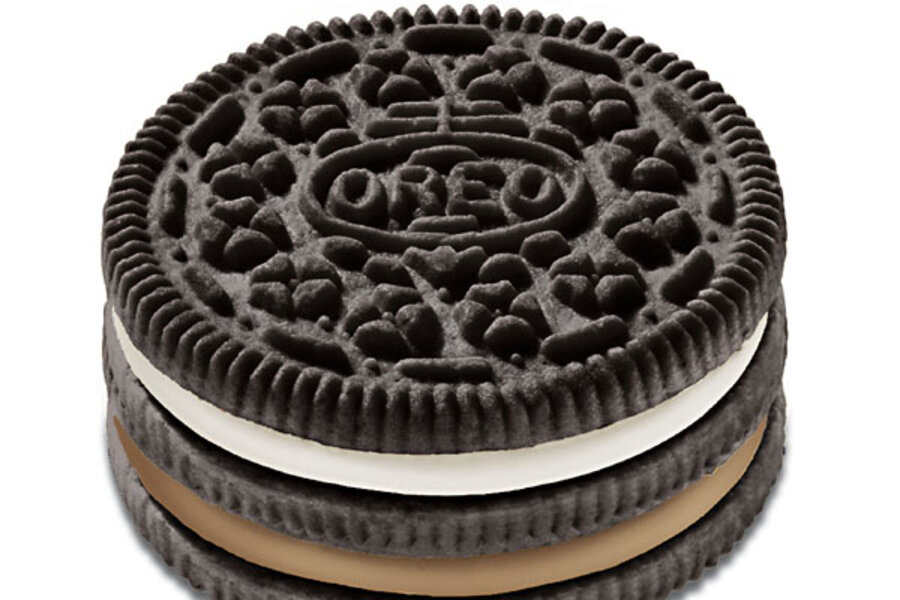Oreo cookie turns 100, celebrates with sprinkles
Loading...
March is a big month for cookie milestones. Next week, the Girl Scouts organization will turn 100 years old. But first, the most enduring and dominant cookie sandwich in the world celebrates its own centennial: the Oreo cookie turns 100 today, March 6, 2012. That makes “Milk’s favorite cookie” older than the sinking of the Titanic (by a month), women’s voting rights, and the Russian Revolution, just to name a few.
To celebrate, Oreo’s parent company, Nabisco (a division of Kraft Foods), has released a limited edition “Birthday Cake” Oreo. It features a simpler cookie design that hearkens back to the original, early 20th -century Oreo logo, as well as that iconic vanilla frosting mixed with rainbow sprinkles.
Oreos were born in a Nabisco factory in the Chelsea neighborhood of New York City. They were sold for 25 cents per pound and packaged in cookie tins. Originally designed to attract British customers, Oreos were first called “Oreo Biscuits.” In 1921, the name changed to the "Oreo Sandwich," then the “Oreo Crème Sandwich” in 1948. The mid-1970s brought the unwieldy “Oreo Chocolate Sandwich Cookie” name change. But by then the brand name had become so closely associated with any chocolate cookie sandwich with a vanilla frosting center that most people simply called them “Oreos.”
Over 490 billion Oreos have been sold in the cookie’s first 100 years, making them far and away the best-selling cookie of the 20th century and an indelible part of American culture. Many people cite the fun of the act of eating an Oreo as a big part of its appeal, with some people eating the sandwiches whole, some pulling them apart, and many dipping them in milk. According to Kraft, an estimated 50 percent of Oreo eaters pull the cookies apart, and women are more likely to do so than men.
The Oreo brand has gotten a lot of ad campaign mileage out of the many ways to eat the cookie: A long-running campaign in the 1990s featured people pulling Oreo sandwiches apart to settle disputes, in the same way you’d flip a coin. Oreo’s current marketing revolves around the Double Stuf Racing League (DSRL), wherein celebrities like the Manning brothers (Eli and Peyton), Shaquille O’Neal, and Donald Trump compete against each other in Oreo-related contests.
Arguably one of the most successful and enduring packaged food products of the modern era (and not experiencing the popularity dropoff suffered by some other formerly iconic food products, including Twinkies), the Oreo brand hasn’t been without its missteps. For one, Oreos are very similar to another chocolate cookie sandwich, the Hydrox cookie. Since Hydrox cookies were introduced in 1908, speculation abounds that Nabisco stole the Oreo idea from Hydrox manufacturer Sunshine, proceeding to dominate the chocolate cookie sandwich market until Hydrox cookies were finally discontinued in 1999.
Furthermore, the Oreo hasn’t been immune to evolving concerns over nutrition and the effect of processed foods on the American diet over its 100-year existence. The crème filling, in particular, has been a sticking point: It was originally made with lard, which was replaced with trans fats in response to public health concerns. But in 2003, Oreos came under fire for those trans fats, and the crème is now manufactured using non-hydrogenated vegetable oil.
Still, the Oreo brand has endured and expanded into several varieties sold in dozens of countries. Some of the more interesting flavors include a Green Tea Oreo (sold in Japan and China), a Banana Split Oreo (briefly available in 2008), and a Blueberry Ice Cream Oreo (sold in Indonesia, Malaysia, and Thailand).
Lastly, let’s not forget the cookie’s influence on the world of pet naming. According to YouPet.com, “Oreo” is the seventh most popular cat name in the United States, just behind “Shadow,” “Tigger,” and “Baby.”





